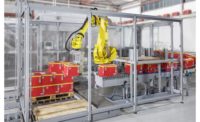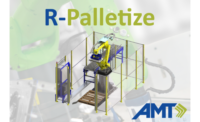The latest palletizers feature modular designs and sophisticated electronics, which facilitate the handling of a wide range of products at high speeds. Other features include refinements in easy-to-clean designs and remote servicing. This is good news for bakers and snack food manufacturers as they seek increased flexibility on the production line.
Sustainability, smaller package sizes, shelf-ready package configurations and packaging waste reduction are here to stay. Like most food manufacturers, bakers and snack producers want to do more with less and look to automated solutions to successfully accomplish this. Palletizers that are flexible, easy to operate and maintain, and able to handle new packaging types down the road are part of the equation.
And big-box stores are driving food producers to offer variety and multipack options. These requests create the need for equipment that’s even more flexible and easy to change over, as smaller case sizes require greater speeds and more complex pallet patterns.
Upgrade and modify
A-B-C Packaging Machine Corp., Tarpon Springs, Fla., is one manufacturer addressing these issues, according to Bryan Sinicrope, vice president of sales and marketing. The company’s new palletizers offer modular designs and sophisticated electronics that allow plants to easily upgrade and modify their equipment as markets evolve. “Virtually all settings are controllable from the operator station, and systems can be programmed remotely,” he says. “The machines utilize industry-standard control systems that are readily networked with plant automation systems.”
A-B-C’s user interfaces are simplified with color-coded, step-by-step operation sequences that make it easy for operators to manage the machine controls. “These HMIs (human machine interfaces) offer more information and options than previous systems, putting a greater degree of control and flexibility into the hands of the plant operators,” Sinicrope adds. “Operation security allows users to set access levels according to plant personnel’s experience.”
Columbia Machine Inc., Vancouver, Wash., recently introduced the HL7200 high-speed inline palletizer, which is suitable for packaging lines that need to quickly adjust for different package types and sizes running at speeds from 72 to 120 cases per minute. The machine features Category 3 electrical safety components, which include dual-channel safety interlocks and full-height light curtains positioned on the full load discharge and empty pallet infeed.
According to Ted Yeigh, Columbia’s sales director, the HL7200 incorporates new programmable laner technology with a soft-turn and configurable layer table that provides accurate, stable layer forming. “Columbia is the first in the conventional inline palletizer industry to provide an HMI that allows the operator to create new patterns or modify existing patterns,” he explains. “This combination makes the machine suitable for reliable handling of current and future package types and sizes.”
Schneider Packaging Equipment Co. Inc., Brewerton, N.Y., recently added two upgrades to its line of robotic palletizing solutions. “Our newest system is a small footprint E3 Robox (robot in a box) design that provides a low-cost, small footprint, end-of-line robotic palletizer,” says Terry Zarnowski, sales and marketing director. The entire unit can be moved by a standard fork truck and installs in a few hours. The base unit can accommodate up to 20 cases per minute with manual pallet exchange. Options include mechanical grippers and semi-automatic pallet exchange with an over/under pallet conveyor system.
Schneider also offers ProAdjust, a plug-and-play system, on its palletizers. “A bakery and snack plant can add ProAdjust onto their production line and reap immediate payback,” Zarnowski says. “For many, the payback can be as little as a few months, depending on the number of changeovers a line goes through. Automating the adjustment points takes out errors and tweaking that can occur for manual adjustments.”
AFA Systems Ltd., Brampton, Ont., recently introduced two new palletizing systems. The AF-PLT Gantry Robot Palletizing System uses a three-axis robot to pick and place a wide variety of products. The compact palletizer has optional features such as slipsheet inserters, pallet dispensers and a washdown construction. “Users can quickly program and change pack patterns on the unit’s HMI,” says Eric Langen, sales and marketing manager. “In addition, the AF-PLT’s modular design allows the machine to be easily integrated into a production line.”
PL-FRB Pick and Place Fanuc Robotic Palletizer, also from AFA Systems, can handle a wide range of product types and sizes. “The PL-FRB comes complete with a four-axis, electric servo-driver with an integrated mechanical and control unit, which ensures fast cycle times and high payloads,” he notes.
Today, bakers and snack food producers also ask for remote servicing on palletizers, which is a new trend, Langen says. “We have customers all over the world, so we install VPN (Virtual Private Network) on all our machines to allow for remote servicing,” he explains. “With this feature, we can troubleshoot problems from our facility, which allows our customers to see a significant reduction in their service costs.”
Langen says he also has seen a shift of end users wanting to take ownership of their equipment. “Servicing equipment, especially with international clients, has become very costly and time-consuming for end users,” he explains. “We have introduced intuitive HMIs for our palletizers. Now users can easily set up new pack patterns, troubleshoot machinery faults and easily access detailed information via our help screens.”
Safety and sustainability
New palletizers also are being designed to accommodate the new food-safety regulations as well as sustainability initiatives. “We manufacture palletizers with sanitary designs and will continue to work with bakery and snack food plants to ensure compliance with new regulations,” says Sinicrope. “Concerning sustainability, A-B-C palletizers are designed for optimum product handling and pallet formation of all types of secondary packaging to accommodate packagers who are minimizing the use of corrugated. These may include shrink-wrapped bundles, trays and display packs.”
According to Yeigh, requests for Category 3 safety requirements have increased in the bakery and snack food segments over the past five years. As a result, Columbia Machine has standardized all of its equipment to include these components.
“Also, the ability for food plants to add or modify patterns is imperative,” he says. “The rate at which products are being introduced or packaging changed demands that end users have greater flexibility. All of Columbia Machine’s palletizers come standard with Product Manager, a feature allowing customers to add or modify a pattern through the HMI.”
Zarnowski, meanwhile, says he sees a greater tendency to pack trays into cases for shipping and palletizing. “This allows bakeries to ship their products farther from their manufacturing plant,” he points out. “We also are seeing an increase in frozen products. In addition, the sheer variety of products is increasing, offering consumers even more choices and, of course, the need to handle increased SKU count in the supply chain.” SF&WB









-(1).jpg?height=200&t=1654746459&width=200)
